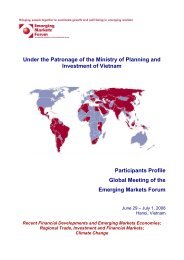The Centennial Resilience Index: Expanding Its Coverage and ...
The Centennial Resilience Index: Expanding Its Coverage and ...
The Centennial Resilience Index: Expanding Its Coverage and ...
You also want an ePaper? Increase the reach of your titles
YUMPU automatically turns print PDFs into web optimized ePapers that Google loves.
THE CENTENNIAL RESILIENCE INDEX: EXPANDING ITS COVERAGE AND TESTING ITS PREDICTIVE POWERFigure7Cross-border bank lending from European banks (US$ million), March 2005–September 2011Source: BIS Consolidated Banking Statistics. Quoted in <strong>The</strong> euro zone crisis <strong>and</strong> developing countries;Isabella Massa, Jodie Keane <strong>and</strong> Jane KennanNote: Consolidated foreign claims of reporting banks, by nationality of reporting banks, immediate borrower basis. Developing countries data onsecondary axis.has particularly affected countries where Europeanfinancial institutions comm<strong>and</strong> a large share of thedomestic banking systems, such as in Central <strong>and</strong>Eastern Europe, as well as in some African countries.In some of these countries, European financial institutionshold more than 50 percent of banking assets.As the European banking system is highly leveraged(assets represent 16 to 18 times the capital basecompared to about 12 times globally), the process ofbalance sheet shrinking is likely to require both capitalincreases <strong>and</strong> asset disposals, the latter possibly affectingEMCs access to funding.<strong>The</strong> impact on EMCs of this deleveraging hasremained contained thus far, at somewhere between€10 <strong>and</strong> €20 billion, equivalent to only 1 to 2 percentof total EMC credit extended by European banks(€1.35 trillion). Scenarios have tried to assess the ultimateimpact of the planned deleveraging, with numbersvarying greatly, depending on the assumptionson the respective shares of deleveraging achievedthrough capital increases <strong>and</strong> asset disposals, as wellas the share of disposals affecting the loan book. 13 Inthe most likely scenario, where banks would increasetheir capital base by 20% <strong>and</strong> allocate only half ofasset disposals to loans, EMCs’ credit would drop byabout 20 percent or as much as $338 billion. Whilethis could be offset in part by other investors, a netfall in European funding to EMCs may constitute asignificant threat to growth in the coming period.This prospect makes a positive resolution to current13 Bank deleveraging: Causes, channels <strong>and</strong> consequencesfor Emerging Markets <strong>and</strong> Developing Countries. Erik FeyenKatie Kibuuka İnci Okter-Robe
















